
Sawai Jai Singh II, was the 29th Kachwaha Rajput ruler of the Kingdom of Amber, who later founded the fortified city of Jaipur and made it his capital. He became the ruler of Amber at the age of 11, after the untimely death of his father Mirza Raja Bishan Singh on 31 December 1699.

Rao Raja Sawai Pratap Singh was the founder king of Alwar State. He belonged to the Naruka clan of Kushwaha dynasty.

The Kachhwaha, is a Rajput clan found primarily in India.
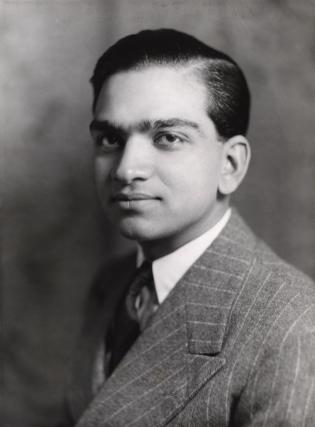
Major General Maharaja Sawai Governor Sir Man Singh II GCSI GCIE was an Indian prince, government official, diplomat and sportsman.

Bhangarh is a village situated in Rajgarh Alwar, Rajasthan state of India. It is situated in the Rajgarh municipality of the Alwar district in Rajasthan. Bhangarh is at the edge of the Sariska Tiger Reserve.

Sawai Madho Singh I was the Kachwaha Rajput ruler of the Kingdom of Jaipur. He was the younger son of Maharaja Sawai Jai Singh II and younger half brother of Sawai Ishwari Singh. He became ruler of Jaipur after his brother Sawai Ishwari Singh died in 1750.
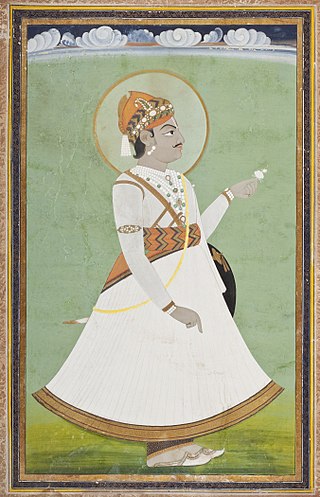
Sawai Pratap Singh was the Kachwaha Rajput ruler of the Kingdom of Jaipur. He was brought on the throne by his mother Maji Chundawatji after the suspicious death of his elder full brother Sawai Prithvi Singh II in 1778. He is known for constructing the magnificent Hawa Mahal in Jaipur in the year 1799.

The Kingdom of Amber, later the Kingdom of Jaipur or the Jaipur State, was located in the north-eastern historic Dhundhar region of Rajputana and was ruled by the Kachwaha Rajput clan. It was established by Dulha Rai, possibly the last ruler of the Kachchhapaghata dynasty of Gwalior who migrated to Dausa and started his kingdom there with the support of Chahamanas of Shakambhari with coalition of Gaur dynasty of sheopur in the 12th century. Mostly through 12th to 15th century, the kingdom faced stagnation, sources were scarce. Under its ruler, Raja Chandrasen of Amber became a Sisodia vassal and fought in the Battle of Khanwa under Raja Prithviraj Kachhwaha.
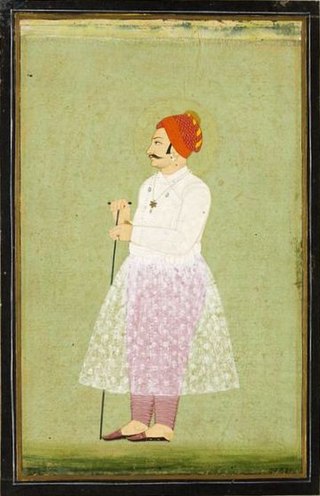
Mirza Raja Bishan Singh was the Kachwaha Rajput ruler of the Kingdom of Amber. He succeeded his grandfather Mirza Raja Ram Singh I since his father Kishan Singh died in the lifetime of his grandfather.He was also the subahdar of the province of Assam from the year 1687 to 1695 in the reigning times of Mughal Emperor Aurangzeb. He was succeeded by Sawai Jai Singh II.
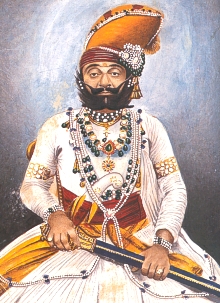
Maharaja Takht Singh, GCSI was first the regent (1839–1841) and the final Maharaja of Ahmednagar (Himmatnagar) 1841–1843 as a result of an agreement with the British. Once he ceded Ahmednagar (Himmatnagar) to Idar, he was recognized as Maharaja of Jodhpur (1843–1873).

Kingdom of Marwar, also known as Jodhpur State during the modern era, was a kingdom in the Marwar region from 1243 to 1818 and a princely state under British rule from 1818 to 1947. It was established in Pali by Rao Siha, possibly a migrant Gahadavala noble, in 1243. His successors continued to struggle against regional powers for domination and 9 out of 15 rulers till 1438 died in combat. In 1395, its capital was changed to Mandore by Rao Chunda of Mandore and to Jodhpur in 1459 by Rao Jodha.
Raja Askaran was a late sixteenth-century Kachwaha Rajput ruler. Though briefly Raja of Amber, for the majority of his life Askaran was the ruler of Narwar. He also had a distinguished career as a military officer under the Mughal emperor Akbar and rose high in his service.

Maharana Jagat Singh II, was the Sisodia Rajput ruler of Mewar Kingdom. He being the eldest among his brothers succeeded to the throne of Mewar.

Sawai Ishwari Singh was the Kachwaha Rajput ruler of Jaipur Kingdom reigning for the seven turbulent and highly unstable political years from 1743 to 1750. He was the second son of Sawai Jai Singh II and elder half brother of his immediate successor Sawai Madho Singh I.
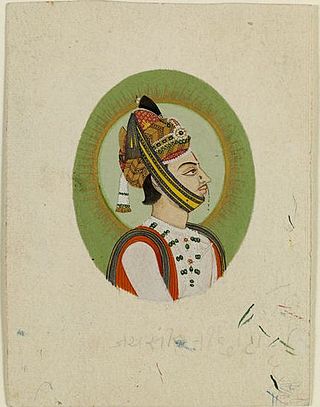
Sawai Jai Singh III, was the Kachwaha-Rajput ruler of Jaipur. He was born posthumously after the sudden death of his father Sawai Jagat Singh of Amber .He was the father of his successor and only son Sawai Ram Singh II
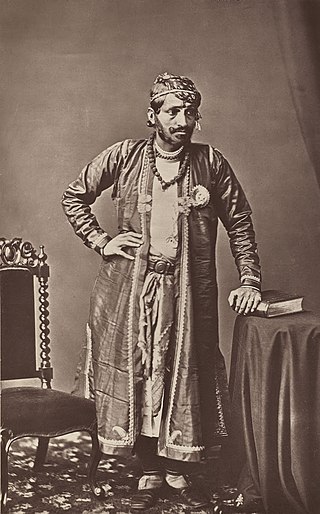
Maharaja Sawai Ram Singh II was the Kachwaha Rajput ruler of Jaipur from 1835 until 1880, succeeding after the death of Sawai Jai Singh III. He became the ruler of Jaipur at the age of 16 months after his father's death. During his reign, he implemented various reforms, influenced by Western ideals and British preferences. He established new departments, reorganized the police force, and constructed roads to promote economic progress. Additionally, he aimed to transform Jaipur into a modern city, introducing schools, colleges, gas lights, and piped water supply. Ram Singh also focused on women's education, building schools and hospitals for their empowerment. Ram Singh was also an avid photographer. His reign marked a period of significant transformation and progress in Jaipur.

HH Saramad-e-Raja-e-Hindustan Raj-Rajeshwar Raj-Rajendra Maharajadhiraj Shri Maharaja Sawai Sir Madho Singh II, was the Maharaja of the Princely State of Jaipur from the year 1880 until 1922. He was the adopted son of the previous ruler Sawai Ram Singh II, Maharaja of Jaipur.
The Battle of Rajamahal was a military engagement fought in 1747 in Jaipur, India. The battle was fought between the forces of Sawai Maharaja Ishwari Singh and Maharana Jagat Singh, who wanted to make his nephew Madho Singh the Maharaja of Jaipur or secure a Jagir for him, he built an alliance with the Maratha's under Khanderao Holkar and the Hada clan of Bundi and Kota. The battle resulted in a decisive victory for Ishwari Singh's forces.
Prithviraj Singh I, also known as Prithvi Singh I, was a 16th-century Rajput ruler of Amber. He was a monarch of strong religious inclinations and during his reign, Amber became increasingly politically active. He took part in the Rajput alliance against the Mughal emperor Babur, fighting against the latter in the Battle of Khanwa alongside Rana Sanga of Mewar in 1527. Three of Prithviraj's sons successively followed him as ruler of Amber, with many of his descendants also populating the kingdom's highest aristocracy in subsequent centuries.
















